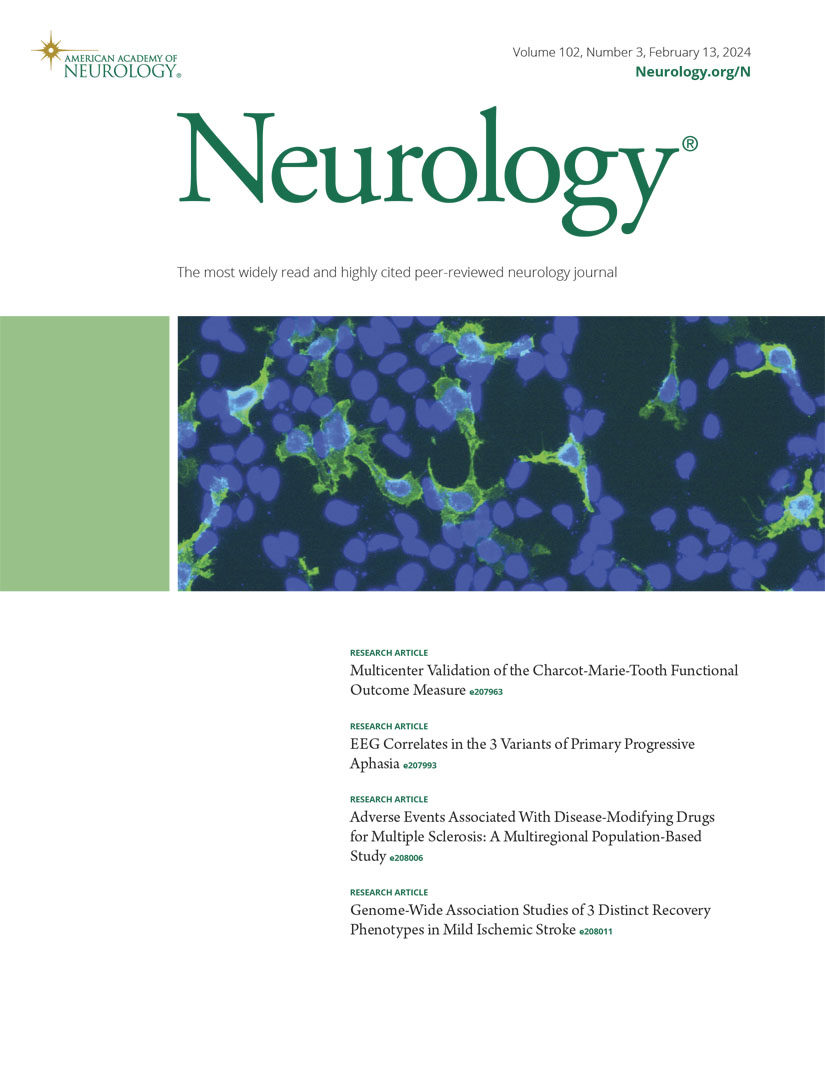Ambient Outdoor Air Pollution and Risk of Tumors of the Central Nervous System.
IF 7.7
1区 医学
Q1 CLINICAL NEUROLOGY
引用次数: 0
Abstract
BACKGROUND AND OBJECTIVES The incidence of CNS tumors has increased over the recent decades, and few risk factors are identified. Ultrafine particles (UFPs) can cross the blood-brain barrier and thereby cause direct intracranial exposure. The aim of this cohort study was to study the possible relationship between air pollution exposure including UFPs and tumors of the CNS. METHODS The study base included all Danish adults (aged 20 years and older) identified from nationwide registries since 1991. We defined the end point as the first, primary CNS tumor identified in the Danish Cancer Registry. We applied Danish national registers for address histories and covariates and a state-of-the-art, validated model for assessment of residential air pollution. Cox proportional hazards models were used to estimate hazard ratios (HRs) with 95% CIs for tumors of the cranial nerves, meningioma, and glioma associated with air pollution exposure. We conducted analyses based on a national emission inventory to allocate air pollution concentrations to contributions from local traffic and other sources. Covariates included socioeconomic and demographic factors at both individual and area levels. RESULTS The study included 3,959,619 adults (mean age 35 years, 49.6% female) and 16,596 cases of CNS tumors. Ten-year mean exposure to UFPs, fine particulate matter (PM2.5), nitrogen dioxide (NO2), and elemental carbon (EC) was associated with the risk of developing meningioma with confounder-adjusted HRs (95% CI) of 1.10 (1.05-1.16) per interquartile range (IQR) for UFPs; 1.21 (1.10, 1.34) per IQR for PM2.5; 1.12 (1.07, 1.18) per IQR for NO2; and 1.03 (1.00, 1.05) per IQR for EC. Source-specific analyses indicated that air pollution from both local traffic and other sources could be influential. Corresponding HRs observed for the other CNS groups were as follows: tumors of the cranial nerves (n = 2,342): 0.94 (0.86-1.02), 0.89 (0.76-1.03), 0.90 (0.83-0.97), and 0.92 (0.87-0.98); glioma (n = 6,197): 1.01 (0.96-1.06), 0.95 (0.87-1.04), 1.02 (0.97-1.06), and 1.01 (0.99-1.04); and other CNS tumors (n = 3,412): 0.96 (0.90-1.02), 0.89 (0.80-1.00), 0.99 (0.94-1.05), and 1.01 (0.98, 1.05). DISCUSSION The findings of this nationwide register-based cohort study indicated that air pollution might contribute to the development of meningioma.室外环境空气污染与中枢神经系统肿瘤的风险。
背景与目的近几十年来,中枢神经系统肿瘤的发病率有所增加,但很少有危险因素被确定。超细颗粒(ufp)可以穿过血脑屏障,从而直接暴露在颅内。本队列研究的目的是研究空气污染暴露(包括ufp)与中枢神经系统肿瘤之间的可能关系。方法研究基础包括1991年以来从全国登记中确定的所有丹麦成年人(20岁及以上)。我们将终点定义为在丹麦癌症登记处发现的第一个原发性中枢神经系统肿瘤。我们应用丹麦国家登记地址历史和协变量和最先进的,验证模型的住宅空气污染评估。使用Cox比例风险模型估计与空气污染暴露相关的脑神经肿瘤、脑膜瘤和胶质瘤的95% ci风险比(hr)。我们根据国家排放清单进行了分析,将空气污染浓度分配给当地交通和其他来源的贡献。协变量包括个人和地区层面的社会经济和人口因素。结果共纳入成人39959619例(平均年龄35岁,女性49.6%)和中枢神经系统肿瘤16596例。十年平均暴露于ufp、细颗粒物(PM2.5)、二氧化氮(NO2)和单质碳(EC)与发生脑膜瘤的风险相关,ufp的混杂校正hr (95% CI)为1.10(1.05-1.16)/四分位数范围(IQR);PM2.5为1.21 (1.10,1.34)/ IQR;二氧化氮每IQR为1.12 (1.07,1.18);每IQR为1.03(1.00,1.05)。特定来源的分析表明,当地交通和其他来源的空气污染都可能产生影响。其他中枢神经系统组相应的HRs分别为:脑神经肿瘤(n = 2342): 0.94(0.86-1.02)、0.89(0.76-1.03)、0.90(0.83-0.97)、0.92 (0.87-0.98);神经胶质瘤(n = 6197): 1.01(0.96 - -1.06), 0.95(0.87 - -1.04), 1.02(0.97 - -1.06),和1.01 (0.99 - -1.04);和其他中枢神经系统肿瘤(n = 3412): 0.96(0.90 - -1.02), 0.89(0.80 - -1.00), 0.99(0.94 - -1.05),和1.01(0.98,1.05)。讨论:这项基于全国登记的队列研究结果表明,空气污染可能导致脑膜瘤的发展。
本文章由计算机程序翻译,如有差异,请以英文原文为准。
求助全文
约1分钟内获得全文
求助全文
来源期刊

Neurology
医学-临床神经学
CiteScore
12.20
自引率
4.00%
发文量
1973
审稿时长
2-3 weeks
期刊介绍:
Neurology, the official journal of the American Academy of Neurology, aspires to be the premier peer-reviewed journal for clinical neurology research. Its mission is to publish exceptional peer-reviewed original research articles, editorials, and reviews to improve patient care, education, clinical research, and professionalism in neurology.
As the leading clinical neurology journal worldwide, Neurology targets physicians specializing in nervous system diseases and conditions. It aims to advance the field by presenting new basic and clinical research that influences neurological practice. The journal is a leading source of cutting-edge, peer-reviewed information for the neurology community worldwide. Editorial content includes Research, Clinical/Scientific Notes, Views, Historical Neurology, NeuroImages, Humanities, Letters, and position papers from the American Academy of Neurology. The online version is considered the definitive version, encompassing all available content.
Neurology is indexed in prestigious databases such as MEDLINE/PubMed, Embase, Scopus, Biological Abstracts®, PsycINFO®, Current Contents®, Web of Science®, CrossRef, and Google Scholar.
 求助内容:
求助内容: 应助结果提醒方式:
应助结果提醒方式:


